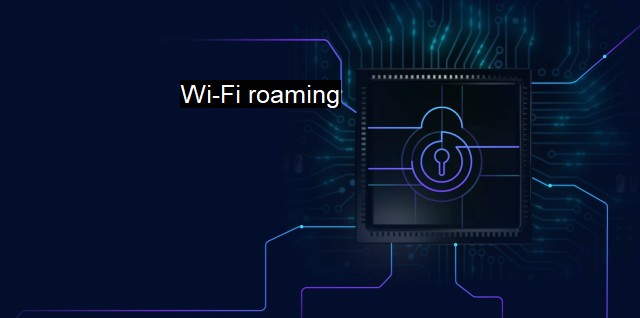What is Wi-Fi roaming?
Wi-Fi Roaming: Seamlessly Staying Connected as You Move Between Networks
Wi-Fi roaming is a term used to describe the process in which a wireless device moves from one access point to another without disruptions in connectivity. This practice is common in extensive Wi-Fi networks, such as those found in large office buildings, hospitals, universities, or even public areas such as shopping centers. Usually, these networks consist of several interconnected access points that allow devices to maintain continuous internet connection as they shift from one coverage area to another.But what implications does this concept have for cybersecurity and antivirus protection?
From a cybersecurity perspective, Wi-Fi roaming increases the vulnerabilities of wireless devices since they are continuously jumping to new access points. Each time a device moves to another access point, it opens a window of opportunity for malicious actors to intercept unsecured data during the handover process. This situation can lead to a range of cybersecurity threats, including the risk of unauthorized access to confidential data, potential for malware or virus intrusion, and susceptibility to Man-in-the-Middle (MitM) attacks whereby a hacker intercepts and alters communications between two parties without their knowledge.
Another significant risk tied to Wi-Fi roaming relates to the safety of the access points themselves. Not all access points within a network may have the same levels of security. A device that roams might jump from a heavily secured access point to a less protected one, exposing it to potential cyber threats. The level of threat increases if the roaming includes public Wi-Fi networks, which are often less secure and susceptible to threats.
For these reasons, organizations should apply robust cybersecurity measures to protect against the increased threats posed by Wi-Fi roaming. Using a virtual private network (VPN) can provide a significant layer of protection. A VPN encrypts all data transmitted over Wi-Fi ensuring that even if a hacker intercepts it, they can't decipher the information. Another safeguarding strategy is to use strong encryption techniques, such as Wi-Fi Protected Access 3 (WPA3), for all networks to reduce their vulnerability to intrusions.
In the context of antivirus protection, Wi-Fi roaming can also present challenges. Whenever a device connects to a new network, it has the potential of bringing along any virus or malware it picked up from a previous less-secured network. Compounding this risk is the fact that devices sometimes temporarily disable their antivirus software during the transition between networks in order to save resources, which inadvertently exposes them to potential threats during that period.
Consequently, businesses and organizations need to ensure that all devices within their system uphold high antivirus standards to counteract these concerns. Preferably, devices should use comprehensive antivirus software that can defend against a wide variety of threats, including viruses, malware, ransomware, and spyware. The antivirus program should also be set to execute regular scans, timely update virus databases, and provide real-time protection, irrespective of changes in the device's Wi-Fi networks during roaming.
Over and above individual device protection measures, companies can implement Network Access Control (NAC) systems. These systems work by limiting the access to the network to only those devices that satisfy stated security policies and have updated antivirus protection. Ensuring that devices have a proper firewall also provides a necessary shield that can block unauthorized access to a computer system, ergo enhancing security during Wi-Fi roaming.
While Wi-Fi roaming offers advantages in terms of connection continuity and convenience, it also brings increased cybersecurity threats and antivirus protection challenges. Applying protective actions such as using VPNs, robust encryption techniques, comprehensive antivirus solutions, implementing network access controls, and establishing system firewalls can aid in decreasing associated risks, thereby creating a safer roaming environment.

Wi-Fi roaming FAQs
What is Wi-Fi roaming and how does it relate to cybersecurity?
Wi-Fi roaming is a feature that allows mobile devices to seamlessly switch their connection from one Wi-Fi access point to another without interruption. This can pose a cybersecurity risk as roaming between networks may expose devices to unsecured Wi-Fi connections.How can Wi-Fi roaming be secured from potential cybersecurity threats?
One way to secure Wi-Fi roaming is by using antivirus software that can detect and block potential threats from accessing the device when it switches to a new network. Additionally, using a virtual private network (VPN) can encrypt data transmissions and protect against eavesdropping on unsecured Wi-Fi networks.What are the benefits of Wi-Fi roaming for businesses and individuals?
Wi-Fi roaming can provide a seamless and uninterrupted internet connection, allowing businesses and individuals to stay connected no matter where they are. This can improve productivity and efficiency for remote workers or people who are always on the go.Is Wi-Fi roaming safe for personal or business use?
Wi-Fi roaming can be safe for personal or business use if proper security measures are taken, such as using a VPN and antivirus software. It is important to be cautious when connecting to public Wi-Fi networks and to verify the authenticity of the network before connecting.| | A | | | B | | | C | | | D | | | E | | | F | | | G | | | H | | | I | | | J | | | K | | | L | | | M | |
| | N | | | O | | | P | | | Q | | | R | | | S | | | T | | | U | | | V | | | W | | | X | | | Y | | | Z | |
| | 1 | | | 2 | | | 3 | | | 4 | | | 7 | | | 8 | | |||||||